Study of Structural and Electronic Behavior of BeH2 as Hydrogen Storage Compound: An Ab Initio Approach
Abstract
The quantum mechanical calculations based on density functional theory (DFT) have been performed to study ground state structural and electronic properties of BeH2 and along with doping of two (BeH2 + 2H) and four (BeH2 + 4H) hydrogen atoms. The generalized gradient approximation (GGA) has been employed for the exchange correlation energy. The most stable space group of BeH2 is Ibam. Its optimized equilibrium unit cell volume, bulk modulus and its first-order pressure derivative, and electronic properties have been obtained. Our predicted unit cell parameters for BeH2 a = 9.2463 Å, b = 4.2352 Å, and c = 7.8464 Å are in very good agreement with the earlier reported experimental and theoretical results. The electronic band structure of BeH2 shows its behavior as an insulator. The stability of BeH2 along with doped hydrogen atoms increases, while the energy band gap decreases with the increase in number of doped hydrogen atoms. On these bases, we predict that BeH2 is a promising material for hydrogen storage.
1. Introduction
Energy storage for the future is a great concern for the researchers and scientists. We need materials like metal hydrides for various potential applications, that is, for hydrogen storage, in fuel cells and internal combustion engines, as electrodes for rechargeable batteries, and in energy conversion devices. The metal hydrides for hydrogen storage need to be able to form hydrides with a high hydrogen-to-metal mass ratio, but they should not be too stable, so that the hydrogen can easily be released without excessive heating. Beryllium and magnesium and beryllium-magnesium-based hydrides contain a relatively high fraction of hydrogen by weight but need to be heated ~250 to 300°C in order to release the hydrogen. The alkali-metal and alkaline-earth-metal hydrides represent series with largely ionic bonding. The high pressure behavior of the alkali-metal monohydrides is expected to parallel of the alkali-metal halides [1]. However, there is no systematic high-pressure study on the alkaline-earth-metal hydrides. If BeH2 becomes metallic when subjected to high pressures, one can entertain the possibility that its properties could resemble those of metallic hydrogen. BeH2 is commonly considered as a covalent hydride with a postulated polymeric crystal structure made up of H-bridged chains. However, mainly owing to experimental difficulties in the synthesis of the material, the structure has long remained unknown [2]. Crystalline BeH2 has been synthesized and the structure has been established as body centered orthorhombic by synchrotron-radiation-based powder X-ray diffraction [3]. First-principles total-energy calculations were performed for various types of structural variants, among which it was confirmed that the experimentally observed body centered orthorhombic (Ibam) structure of BeH2 has the lowest total energy.
In this paper, we have carried out the first-principles calculations of the ground-state behavior of BeH2 in Ibam phase. Results for the structural and electronic properties are systematically presented. The calculations have also been extended for extra hydrogen added structures (BeH2 + 2H and BeH2 + 4H) in the same phase. The obtained results are discussed in this paper.
2. Computational Details
The structural and electronic properties of the BeH2 are obtained using density functional theory (DFT) [7, 8]. The full potential-linearized augmented plane wave (FP-LAPW) method has been employed for the calculation as implemented in the Wien2k code [9]. Generalized gradient approximation (GGA) is used to calculate the exchange-correlation functional. We expand the basis function up to RMT*kmax = 7, where RMT is the smallest radius of the muffin-tin (MT) spheres and kmax is the maximum value of the reciprocal lattice vectors. The maximum l value for the wave function expansion inside the atomic spheres was confined to lmax = 10. The k-points used in the calculations were based on 5 × 5 × 5 Monkhorst-Pack scheme [10]. The iteration process was repeated until the calculated total energy and charge of the crystal converge to less than 0.0001 Ry and 0.001 e−, respectively. In order to avoid ambiguities regarding the calculated results, we have used the same value of the energy cutoff as well as k-grid density for convergence for all the structural variants studied. The present theoretical approach has been successfully applied to study ambient- and high-pressure phases computationally.
The bulk BeH2 exhibits Ibam structure in ground state. The obtained unit cell parameters for this structure of BeH2 are listed in Table 1. In order to obtain the equilibrium structural parameters, we carried out optimization of the total energy as a function of unit cell volume. Obtained sets of the unit cell volume and corresponding total energy have been fitted to the Murnaghan’s equation of state [11]. The bulk BeH2 has also been studied with added number of hydrogen for the purpose of comparison between the ground state electronic properties of BeH2 and with the doped hydrogen BeH2. The studied variants are BeH2 + 2H and BeH2 + 4H. The obtained structural parameters for all the variants have been listed in Table 1.
3. Results and Discussion
3.1. Structural Properties
The ground state of BeH2 has been synthesized experimentally [3] and studied theoretically [5]. Its orthorhombic unit cell (space group Ibam) is composed of twelve BeH2 formula units as shown in Figure 1(a).
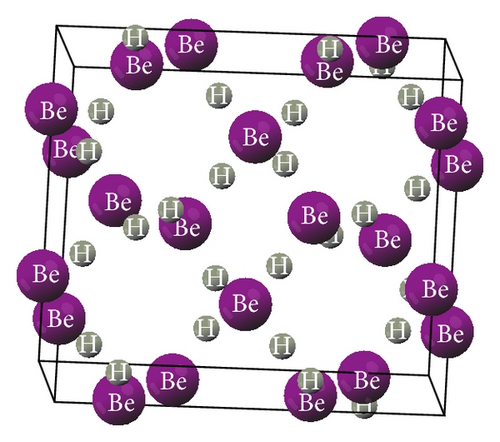
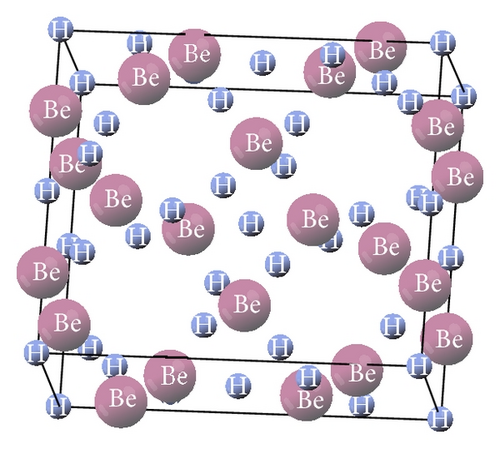
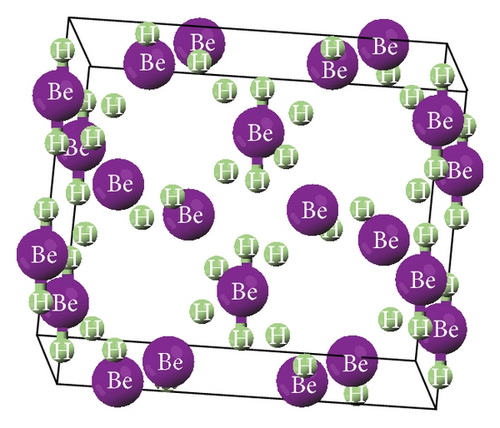
The primitive cell contains six formula units. The Wyckoff positions of different atoms are two Be1 (4a), four Be2 (8j), eight H1 (16k), and four H2 (8j). Each Be1 is surrounded by four H1 atoms to build the tetrahedral structure and each Be2 connects with two H1 atoms and two H2 atoms. Calculated atomic structural parameters for orthorhombic BeH2 are included in Table 1. The obtained results of BeH2 are in excellent agreement with the previous theoretical results [5, 6] and available experimental data [3, 4].
BeH2 also studied with two and four extra added hydrogen atoms. Optimized values for unit cell volume and corresponding energy are fitted to Murnaghan’s equation of state [11]. The optimization curve is shown in Figure 2. From the optimized unit cell volume, we have calculated the lattice parameters of BeH2 + 2H and BeH2 + 4H. The obtained unit cell parameters and other constants are listed in Table 1.
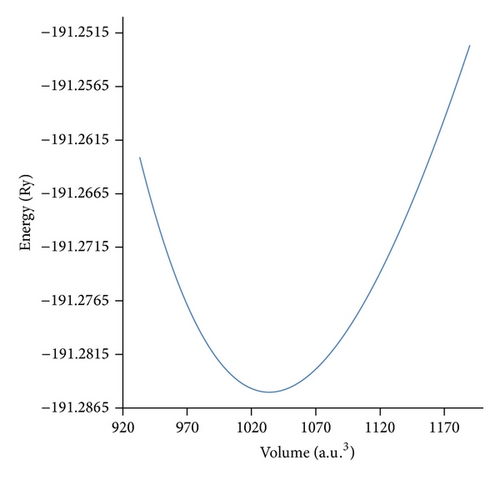
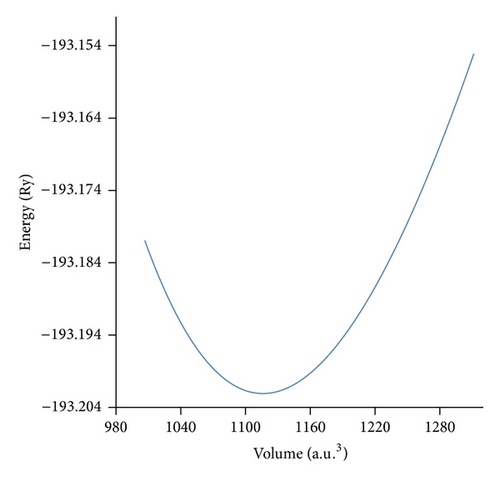
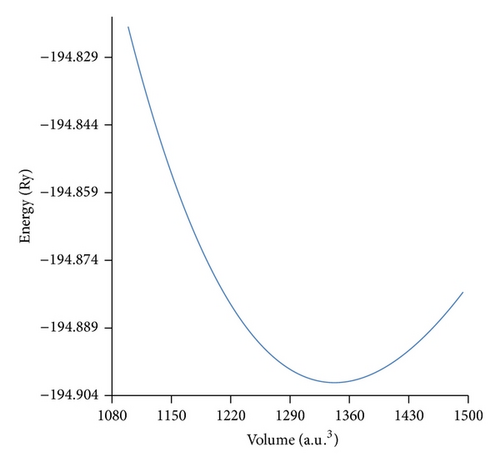
It is evident from Table 1 and plots in Figure 2 that the optimized energy of BeH2 is less than that of BeH2 + 2H and the energy of BeH2 + 2H is less than that of BeH2 + 4H. This indicates clearly that the stability of structures increases with the increase in the number of hydrogen atoms. A plot of total energy as a function of the doped hydrogen atoms is shown in Figure 3(a) and plot of unit cell volume versus number of doped hydrogen atoms is shown in Figure 3(b). The plot in Figure 3(a) shows linear behavior, while plot in Figure 3(b) is nonlinear.
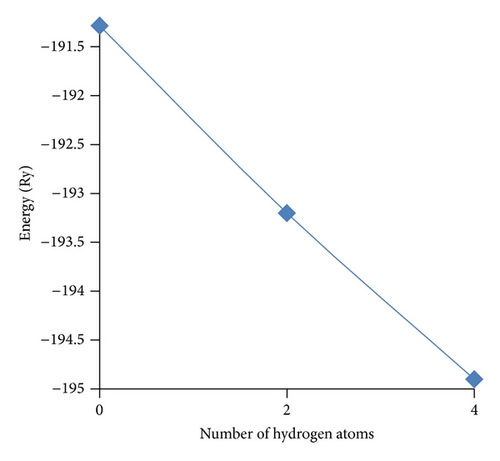
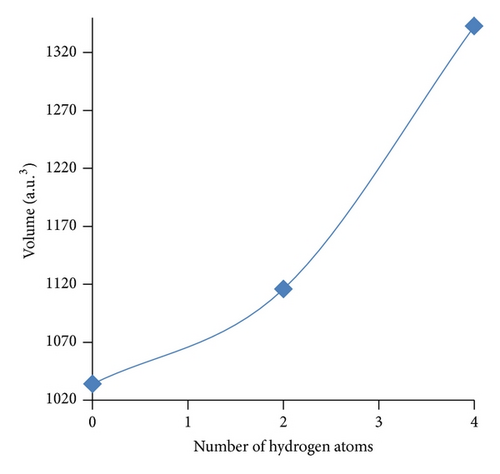
The band structure of BeH2 shows insulator behavior as in this case direct energy band gap is ~5.8 eV, while band structure plots for BeH2 + 2H and BeH2 + 4H show semiconducting behavior because in these cases indirect energy band gaps are, respectively, ~2.2 eV and ~2.5 eV (Figure 4). It is very interesting to note that below Fermi energy level width of a group of valence-band is ~6.5 eV which is in excellent agreement with earlier reported data [5]. The width of the group of valence-bands increases with the increase in number of doped hydrogen atoms. For BeH2 + 2H, this width is ~6.5 eV and for BeH2 + 4H it is ~7.5 eV. The behavior of conduction bands is somewhat different. Corresponding to two doped hydrogen atoms conduction bands near Fermi level are separated, while for 6 doped hydrogen atoms they are further compressed. This shows that number of added hydrogen atoms has significant effect on energy levels.
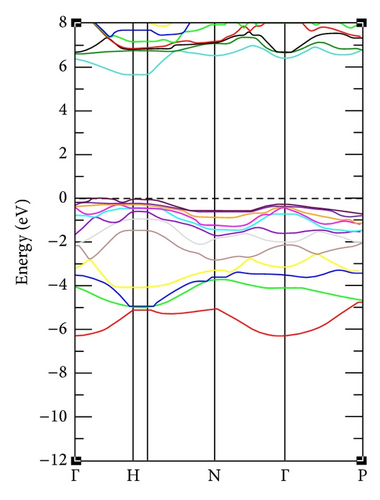
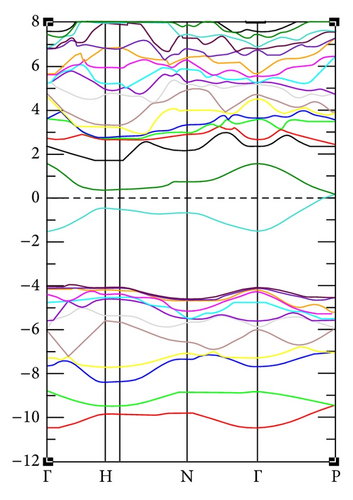
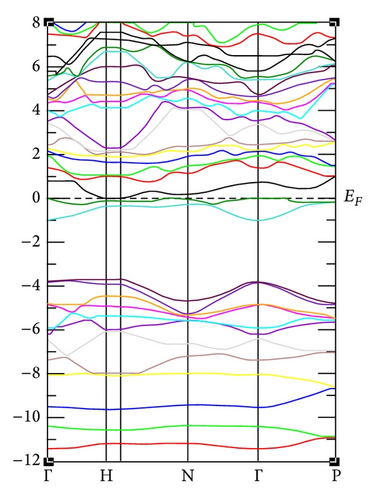
4. Conclusions
In this work, the structural stability of the Beryllium Hydride, BeH2, and doped hydrogen compounds BeH2 + 2H and BeH2 + 4H have been studied by the first-principles calculations. The equilibrium structures of these compounds are obtained from DFT/GGA total energy minimization. The obtained results for BeH2 are in excellent agreement with the reported experimental and theoretical results. BeH2 is an insulator and BeH2 + 2H and BeH2 + 4H are semiconductor. The effect of added hydrogen atoms is very clear. The stability of BeH2 + 4H > BeH2 + 2H > BeH2. Lower value of total energy in BeH2 + 4H shows that hydrogen storage in BeH2 is one of very good option (Figure 2).
Conflict of Interests
The authors declare that there is no conflict of interests regarding the publication of this paper.




